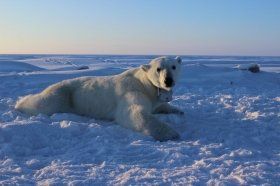The study, published February 2 in Science, reveals the physiological mechanisms behind observed declines in polar bear populations, said first author Anthony Pagano, a Ph.D. candidate at UC Santa Cruz.
"We've been documenting declines in polar bear survival rates, body condition, and population numbers over the past decade," he said. "This study identifies the mechanisms that are driving those declines by looking at the actual energy needs of polar bears and how often they're able to catch seals."
Pagano, who is also a wildlife biologist with the U.S. Geological Survey (USGS), conducted the study as part of his Ph.D. thesis research at UC Santa Cruz, where he has been working with coauthors Terrie Williams and Daniel Costa, both professors of ecology and evolutionary biology.
Read more at University of California - Santa Cruz
Image: This is an adult female polar bear on the sea ice wearing a GPS satellite video-camera collar. GPS video-camera collars were applied to solitary adult female polar bears for 8 to 12 days in April, 2014-2016. These collars enabled researchers to understand the movements, behaviors, and foraging success of polar bears on the sea ice. (Credit: Anthony Pagano, USGS)


